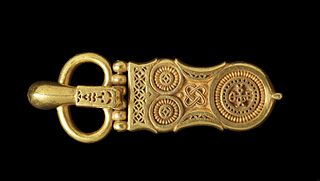 W
WA belt buckle is a buckle, a clasp for fastening two ends, such as of straps or a belt, in which a device attached to one of the ends is fitted or coupled to the other. The word enters Middle English via Old French and the Latin buccula or "cheek-strap," as for a helmet. Belt buckles and other fixtures are used on a variety of belts, including cingula, baltea, baldrics and later waist-belts.
 W
WThe belt hook is a device for fastening that predates the belt buckle.
 W
WThe buckle or clasp is a device used for fastening two loose ends, with one end attached to it and the other held by a catch in a secure but adjustable manner. Often taken for granted, the invention of the buckle was indispensable in securing two ends before the invention of the zipper. The basic buckle frame comes in a variety of shapes and sizes depending on the intended use and fashion of the era. Buckles are as much in use today as they have been in the past: used for much more than just securing ones belt, instead they are one of the most dependable devices in securing a range of items.
 W
WIn modern clothing and fashion design, a button is a small fastener, now most commonly made of plastic but also may be made of metal, wood, or seashell, that joins two pieces of fabric together. In archaeology, a button can be a significant artifact. In the applied arts and in craft, a button can be an example of folk art, studio craft, or even a miniature work of art.
 W
WButtonholes are reinforced holes in fabric that buttons pass through, allowing one piece of fabric to be secured to another. The raw edges of a buttonhole are usually finished with stitching. This may be done either by hand or by a sewing machine. Some forms of button, such as a frog, use a loop of cloth or rope instead of a buttonhole. Buttonholes can also refer to flowers worn in the lapel buttonhole of a coat or jacket, which are referred to simply as "buttonholes" or boutonnières.
 W
WA buttonhook is a tool used to facilitate the closing of buttoned shoes, gloves or other clothing. It consists of a hook fixed to a handle which may be simple or decorative as part of a dresser set or chatelaine. Sometimes they were given away as promotions with product advertising on the handle. To use, the hook end is inserted through the buttonhole to capture the button by the shank and draw it through the opening.
 W
WA collar pin is a piece of men's jewelry, which holds the two ends of a dress shirt collar together and passes underneath the knot of a necktie. Functioning in a similar way as a tabbed collar, it keeps the collar in place and lifts the knot to provide a more aesthetically pleasing arc to the necktie.
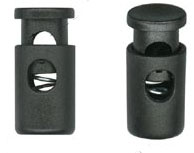 W
WA plastic cord lock attaches to drawstrings and tightens without the use of knots. Cord locks allow mountaineers to fasten clothing and camping equipment quickly in cold conditions when the fingers are encased in heavy gloves. They consist generally of three parts: a barrel, a toggle (plunger), and a spring. Squeezed together, tension is released and the cord lock can move freely up and down the cords. Released, the tension is engaged and the cord lock stays in place. They come in many sizes and shapes to suit to any purpose, including plastic cord lock, mini size cord lock, no spring cord lock, with spring cord lock, with rim cord lock.
 W
WA drawstring is a string, cord, lace, or rope used to "draw" fabric or other material. The ends of the drawstring may be tied to hold it in place. Alternatively, the drawstring may be kept drawn using a cordlock. Typically, the drawstring is loose when not being used and tightened when needed during use.
 W
WA fibula is a brooch or pin for fastening garments, typically at the right shoulder. The fibula developed in a variety of shapes, but all were based on the safety-pin principle. Unlike most modern brooches, fibulae were not only decorative; they originally served a practical function: to fasten clothing, such as cloaks. In English, "fibula" is not a word used for modern jewellery, but by archaeologists, who also use "brooch", especially for types other than the ancient "safety pin" types, and for types from the British Isles.
 W
WA fly on clothing is a covering over an opening concealing the mechanism, such as a zip or buttons, used to close the opening. An open fly is a fly that has been left unzipped or unbuttoned.
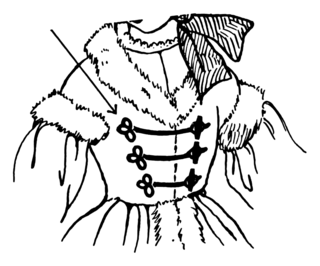 W
WA frog fastener is an ornamental braiding, consisting of a button and a loop, for fastening the front of a garment. The purpose of frog fasteners is to provide a decorative closure for a garment; frog fasteners are usual to garments of Asian design, such as a shirt or coat with a mandarin collar, which features frog fasteners at the shoulder and down the front of the garment. In the design of a garment, frogging is the use of braided, frog fasteners is a detail of the overall design of the garment.
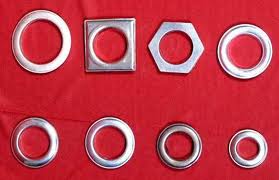 W
WA grommet is a ring or edge strip inserted into a hole through thin material, typically a sheet of textile fabric, sheet metal or composite of carbon fiber, wood or honeycomb. Grommets are generally flared or collared on each side to keep them in place, and are often made of metal, plastic, or rubber. They may be used to prevent tearing or abrasion of the pierced material or protection from abrasion of the insulation on the wire, cable, line being routed through the penetration, and to cover sharp edges of the piercing, or all of the above.
 W
WA hook-and-eye closure is a very simple and secure method of fastening garments together. It consists of a metal hook, commonly made of flattened wire bent to the required shape, and an eye of the same material into which the hook fits.
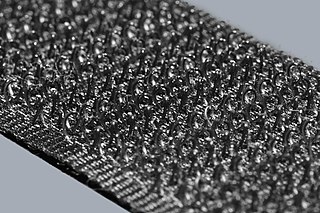 W
WHook-and-loop fasteners, hook-and-pile fasteners or touch fasteners consist of two components: typically, two lineal fabric strips which are attached to the opposing surfaces to be fastened. The first component features tiny hooks, the second features smaller loops. When the two are pressed together the hooks catch in the loops and the two pieces fasten or bind temporarily. When separated, by pulling or peeling the two surfaces apart, the strips make a distinctive "ripping" sound.
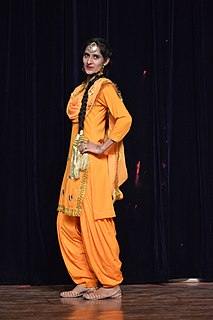 W
WIzarband (naada, izārband, Izar band, Kamarband, Kamar Ki Patti and Patka, ازار بند) is a kind of girdle. Izarband is used to tie the upper part of various dresses such as salwar, pajamas, ghagra, petticoat, etc., in the Indian subcontinent. The said garments have the upper side turned inwards and stitched to make a narrow tubular passage, in which the izarband passes, there is one opening in the front side to collect and tie/ knot the ends. Izarband was one of the accessory (closures) items of textiles produced in the Punjab region. The Izarband is similar to a drawstring but narrower than a katzeb or a sash.
 W
WThe kilt pin is a piece of jewellery that is usually worn on the lower corner of the outer apron of a kilt. Its function is to prevent the apron falling or blowing open, by adding weight to the outer apron and is commonly seen as a form of decoration. It does not pin the outer apron to the inner fabric, which is a common misconception.
 W
WA metal zipper is a zipper with its binding edges consisting of individual pieces of metal that are molded into shape and set at regular intervals on the zipper tape. Metal zippers are mainly made of brass, nickel and aluminium, and given their durability, they are mostly used in jeans, work-wear, heavy luggage and heavy-duty garments that must withstand high strength and tough washing. The metal zipper is the oldest type of workable zipper, having been invented by Gideon Sundback as an improvement of Whitcomb Judson's "Clasp Locker" that majorly consisted of a hook-and-eye shoe fastener.
 W
WPetersham ribbon, also called Petersham facing or simply Petersham, is a thick, stiff, flexible corded ribbon usually made out of either cotton, rayon, viscose, or a cotton/ rayon or viscose blend of fibers and used as facing by milliners and tailors. Petersham is frequently watered on both sides and comes with a scalloped edge. It is woven so that once steamed, it will take on and support a particular curve of fabric. This makes it useful for obtaining a smooth edge on the brim of a hat, for example, without forming puckers or wrinkles which would result from the use of traditional flat ribbon or other flat fabric. It is also useful as an alternative to bias tape for making fabric conform closely to the shape of the body wearing it— in a corset, for example, or along the waistline of a pair of trousers or a skirt. Petersham is utilized in couture sewing as a form of interfacing as way to stabilize waistbands.
 W
WA pin is a device used for fastening objects or material together, and can have three sorts of body: a shaft of a rigid inflexible material meant to be inserted in a slot, groove, or hole ; a shaft connected to a head and ending in a sharp tip meant to pierce one or more pieces of soft materials like cloth or paper ; a single strip of a rigid but flexible material whose length has been folded into parallel prongs in such fashion that the middle length of each curves towards the other so that, when anything is inserted between them, they act as a clamp, or two strips of a rigid material bound together by a spring at one end so that, when the spring held open, one can insert some material between the prongs at the other end that, the spring allowed to close, then clamp the inserted material. According to their function, pins can be made of metals, wood, or plastic.
 W
WA placket is an opening in the upper part of trousers or skirts, or at the neck or sleeve of a garment. Plackets are almost always used to allow clothing to be put on or removed easily, but are sometimes used purely as a design element. Modern plackets often contain fabric facings or attached bands to surround and reinforce fasteners such as buttons, snaps, or zippers.
 W
WA ribbon or riband is a thin band of material, typically cloth but also plastic or sometimes metal, used primarily as decorative binding and tying. Cloth ribbons are made of natural materials such as silk, cotton, and jute and of synthetic materials, such as polyester, nylon, and polypropylene. Ribbon is used for useful, ornamental, and symbolic purposes. Cultures around the world use ribbon in their hair, around the body, and as ornamentation on non-human animals, buildings, and packaging. Some popular fabrics used to make ribbons are satin, organza, sheer, silk, velvet, and grosgrain.
 W
WA rivet is a permanent mechanical fastener. Before being installed, a rivet consists of a smooth cylindrical shaft with a head on one end. The end opposite to the head is called the tail. On installation, the rivet is placed in a punched or drilled hole, and the tail is upset, or bucked, the head is supported against the direction of the tail when upsetting so it will stay on place, the tail expands to about 1.5 times the original shaft diameter, holding the rivet in place. In other words, the pounding or pulling creates a new "head" on the tail end by smashing the "tail" material flatter, resulting in a rivet that is roughly a dumbbell shape. To distinguish between the two ends of the rivet, the original head is called the factory head and the deformed end is called the shop head or buck-tail.
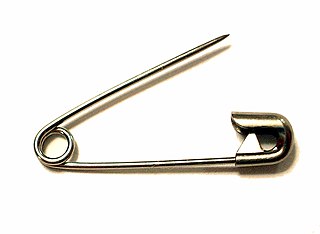 W
WThe safety pin is a variation of the regular pin which includes a simple spring mechanism and a clasp. The clasp serves two purposes: to form a closed loop thereby properly fastening the pin to whatever it is applied to, and to cover the end of the pin to protect the user from the sharp point.
 W
WA shank is a device for providing a small amount of space in between a garment and a button. Shanks are necessary to provide space for fabric to sit in between the button and the garment when the garment is buttoned. Shanks also allow a garment to hang and drape nicely.
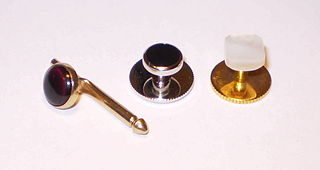 W
WA shirt stud is a decorative fastener that fits onto a buttonhole on the front of a pleated shirt, or onto the starched bib of a stiff-front shirt. Such shirts have special buttonholes solely for shirt studs.
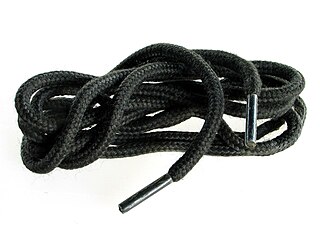 W
WShoelaces, also called shoestrings or bootlaces, are a system commonly used to secure shoes, boots, and other footwear. They typically consist of a pair of strings or cords, one for each shoe, finished off at both ends with stiff sections, known as aglets. Each shoelace typically passes through a series of holes, eyelets, loops or hooks on either side of the shoe. Loosening the lacing allows the shoe to open wide enough for the foot to be inserted or removed. Tightening the lacing and tying off the ends secures the foot firmly within the shoe. The laces can be tied in different shapes, most commonly a simple bow.
 W
WA snap fastener is a pair of interlocking discs, made out of a metal or plastic, commonly used in place of traditional buttons to fasten clothing and for similar purposes. A circular lip under one disc fits into a groove on the top of the other, holding them fast until a certain amount of force is applied. Different types of snaps can be attached to fabric or leather by riveting with a punch and die set specific to the type of rivet snaps used, sewing, or plying with special snap pliers.
 W
WA strap, sometimes also called strop, is an elongated flap or ribbon, usually of leather or other flexible materials.
 W
WA tri-glide slide, also called a webbing slide, is a small item of hardware made of plastic or metal forming a rectangle with a bar in the middle—there are thus two separate openings. They are utilized when webbing is slid through one and then out of the other opening, for the purpose of the strap being effectively shortened or lengthened to an extent. As everyone varies in size, they are often used on objects that are worn, such as pet harnesses, bras, belt bags, diving masks, personal flotation jackets, caps, gun slings, etc., so that these objects can be adjusted to not fit the wearer too constrictedly or loosely, but comfortably while still tight enough. They are made in different dimensions because of varying strap width and thickness.
 W
WA zipper, zip, fly, or zip fastener, formerly known as a clasp locker, is a commonly used device for binding the edges of an opening of fabric or other flexible material, such as on a garment or a bag. It is used in clothing, luggage and other bags, sporting goods, camping gear, and other items. Zippers come in all different sizes, shapes, and colors. Whitcomb L. Judson, who was an American inventor from Chicago, is sometimes given credit as the inventor of the zipper, but he never made a practical device. The method, still in use today, is based on interlocking teeth. Initially, it was titled the "hookless fastener" and was later redesigned to become more reliable.